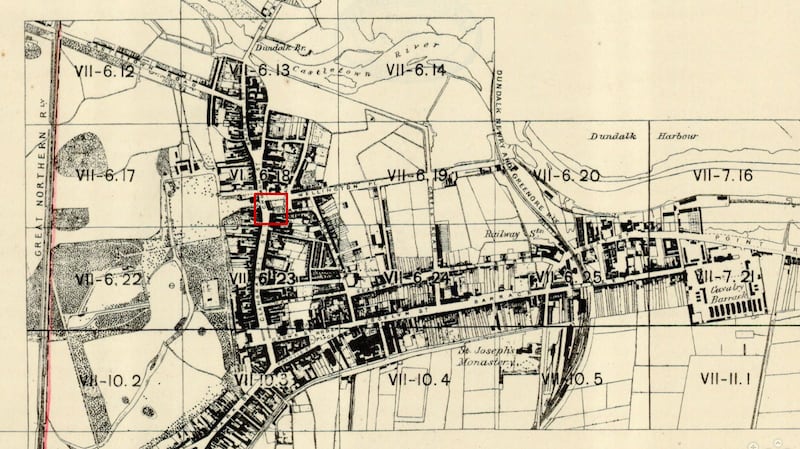Costello had no time for Patrick Fitzsimons. The former was the head constable at Bridge Street and the latter a 21-year-old, unmarried man with no “visible employment” and a name for drinking. It was after 11pm on Sunday January 16th, 1870, when the tipsy complainant tried to report an assault. He sported a nasty eye wound.
His father consulted me repeatedly about him, to endeavour to get him out of company he kept in
“I observed after listening to him, he had a cut under his left eye,” recalled the policeman, after Fitzsimons named his alleged attacker - later identified as James Murphy.
Swelled, blackened and closed. Costello described the dire state of Fitzsimons’s eye, but “saw nothing more about him than what I would expect in any other Rowdy that would be out at drinking, as to my own knowledge he was constantly, and about which I spoke to him repeatedly in order to reform him. His father consulted me repeatedly about him, to endeavour to get him out of company he kept in.”
Costello didn’t bother inquiring about the circumstances of the incident. A blow of a “stick” was mentioned, but Costello didn’t trust the man’s memory enough to ask. Besides, as the constable, put it, “if he had told me, (I) would not believe him.”
Costello advised the young man to take out a summons against Murphy, and to see a doctor about dressing his eye.
Three days later, Fitzsimons lay dead on the examination table of Dr George Edward Bunker.
At an inquest on the same day, January 19th, the pieces of the unfortunate story came together. Michael Murphy, an acquaintance of Fitzsimons, described, on the face of it, a typical drunken row.
Michael, the deceased, and a man named Peter Coleman were standing near St Nicholas’s church at Hart’s corner, where Patrick Fitzsimons had stopped to “make water”. They had been drinking at Hart’s public house since about 2.30pm. Fitzsimons had seven or eight glasses of porter on board.
There are two churches named St Nicholas’s on the same street in Dundalk - one Roman Catholic and one Church of Ireland. Griffith’s valuation 1854 says a man named James Hart occupied a building on Church Street including a house and graveyard - likely the plot just south of the Church of Ireland building. This locates the following incident there, as opposed to near the younger Catholic church a short distance north up the road.

‘A bitch’s get’
James Murphy - referred to as “Murphy” in the depositions - happened to pass the trio gathered on Church Street. Unprovoked, Fitzsimons shouted what The Irish Times reported were “offensive” and “objectionable” expressions at the passerby.
The slurs the newspaper felt were too scurrilous to repeat are preserved in the inquest records: “Fitzsimons called him a bitch’s get - Murphy was on the footpath, he came back to Fitzsimons,” recalled Michael, who said Fitzsimons later augmented the insult, saying “he would break Murphy’s head for a stoolly bitch’s get.”
Peter Coleman recalled the insult slightly differently, as “stoolly son of a bitch”. The sentiment remained the same. Murphy, retaliating, called Fitzsimons a “beggar” and a “rascal”.
No punches were thrown, and the passerby walked away, about 15 yards. Fitzsimons shouted a second time. Again, the men took a fighting stance. Murphy - not quite sober himself - was carrying an umbrella and warned Fitzsimons to back off.
“Murphy then just gave Fitzsimon a punch of the umbrella in the left eye then ran away shouting ‘police’,” said Michael.
Fitzsimons staggered and lost balance, falling on his backside. There was no scream of agony. He simply said: “My eye is out.”
I found the left eyelids greatly swollen and the upper one filled with blood so much so that it was impossible to get a look at the eye
“I took him up immediately, looked at his eye which was quite clean looking, a little blood coming from under the eye,” Michael told the inquest. “I told him he would have a black eye anyway.”
By 10am the next morning, Fitzsimons sat on a seat in the local dispensary with his head leaning against the wall and a cloth over his face. He told the attending doctor, John Brown, his eye had been hurt.
Dr Brown wasn’t optimistic: “I found the left eyelids greatly swollen and the upper one filled with blood so much so that it was impossible to get a look at the eye, so as to be certain whether it had been injured. From the appearance however of the surrounding parts, I greatly feared the eye had been destroyed...”
His fears were confirmed by Dr Bunker upon Fitzsimons’s admission to the Louth infirmary the next day. Dr Bunker applied lotion to the useless eye, gave a sickly Fitzsimons some medicine and sent him to bed. He was dead by 6am the next morning, having been found foaming at the mouth by a porter in the middle of the night.
Brain
The post mortem revealed the wound to be more devastating than the physicians could have guessed. The umbrella, Dr Bunker concluded, had passed through Fitzsimon’s eye, through the top of his eye socket, and travelled 2 inches into his brain.
Dr Bunker told the inquest that “on opening the skull a fracture of the bone forming the roof of the orbit was evident - some effusion of blood and a wound of the corresponding part of the brain extending at least two inches into its structure - an umbrella was produced - which appears to me to be capable of producing the above described injury.”
The base of the ferrule of the umbrella, he said, had likely made the smaller cut which sat beneath the eye.
“We find that the deceased died from effects of a wound on the brain, inflicted upon him on the 16th instant by James Murphy,” concluded the inquest jury, according to an Irish Times report.

James Murphy, a “respectable steady man” by head constable Costello’s glowing assessment, was convicted of manslaughter and sentenced to one month in prison.
Not long after Murphy’s conviction in March, a group wrote a letter in a bid to get the sentence - deemed at the “extreme” end by the memorial writers - reduced or quashed, partially on medical grounds.
Dr Bunker examined Murphy, who was said to be suffering from a congested right lung caused by disease. Considering his remaining sentence was so short, the doctor was happy he would be able to serve the rest of his time without putting his life at risk.



















